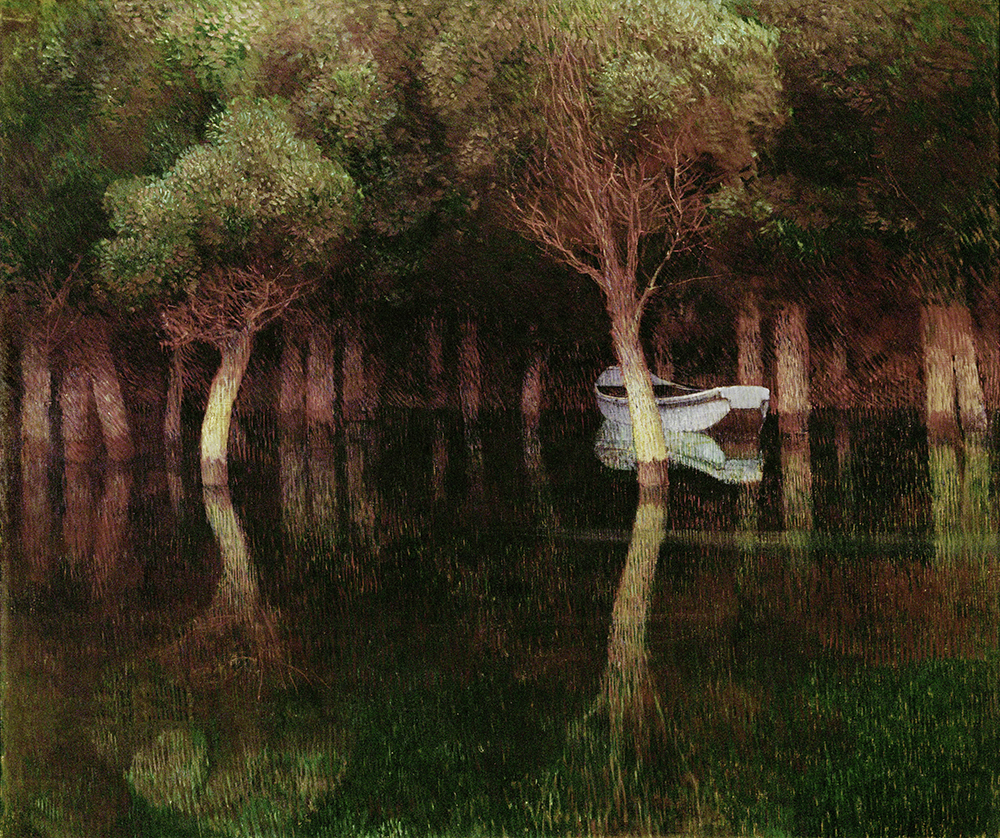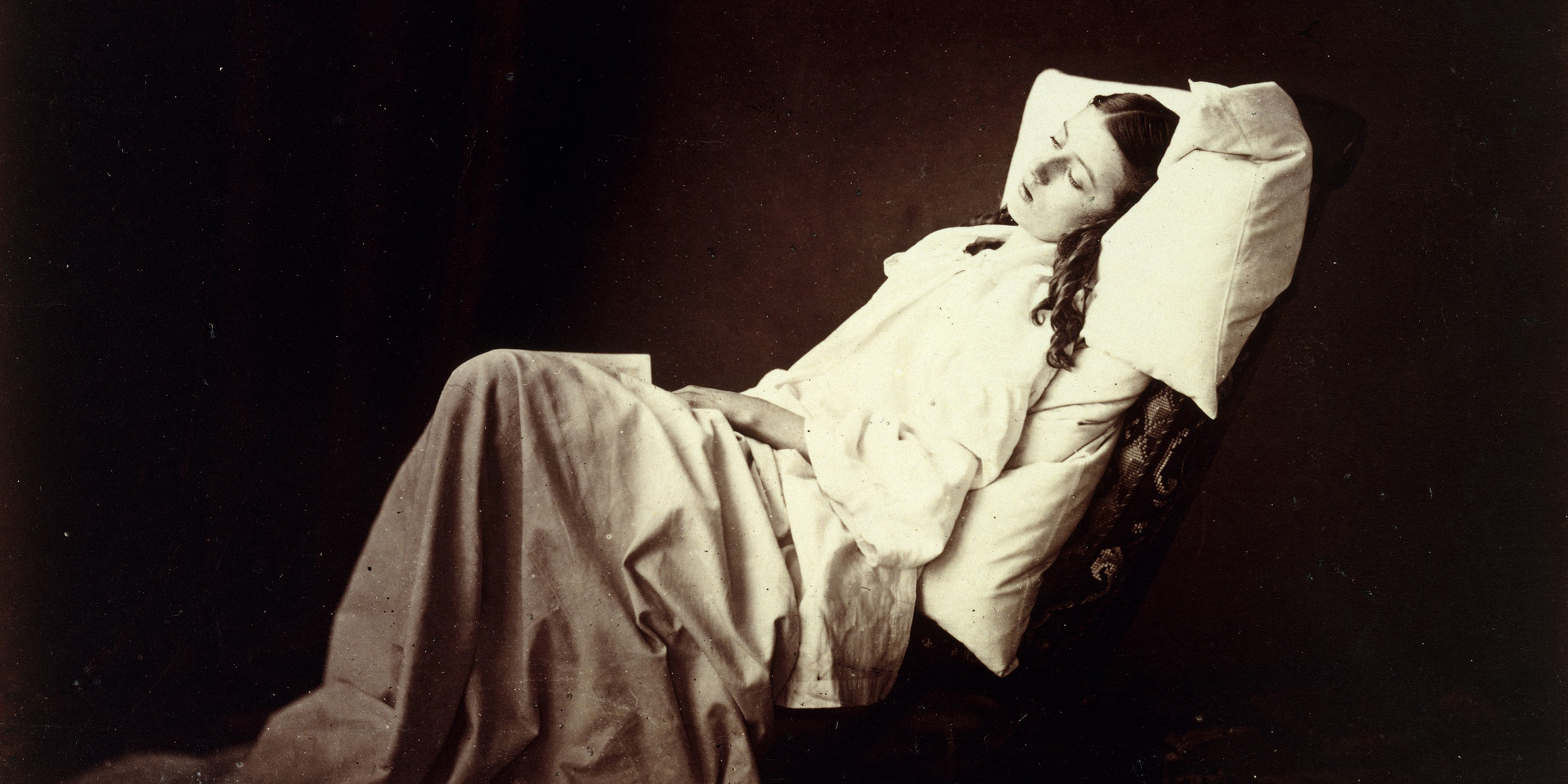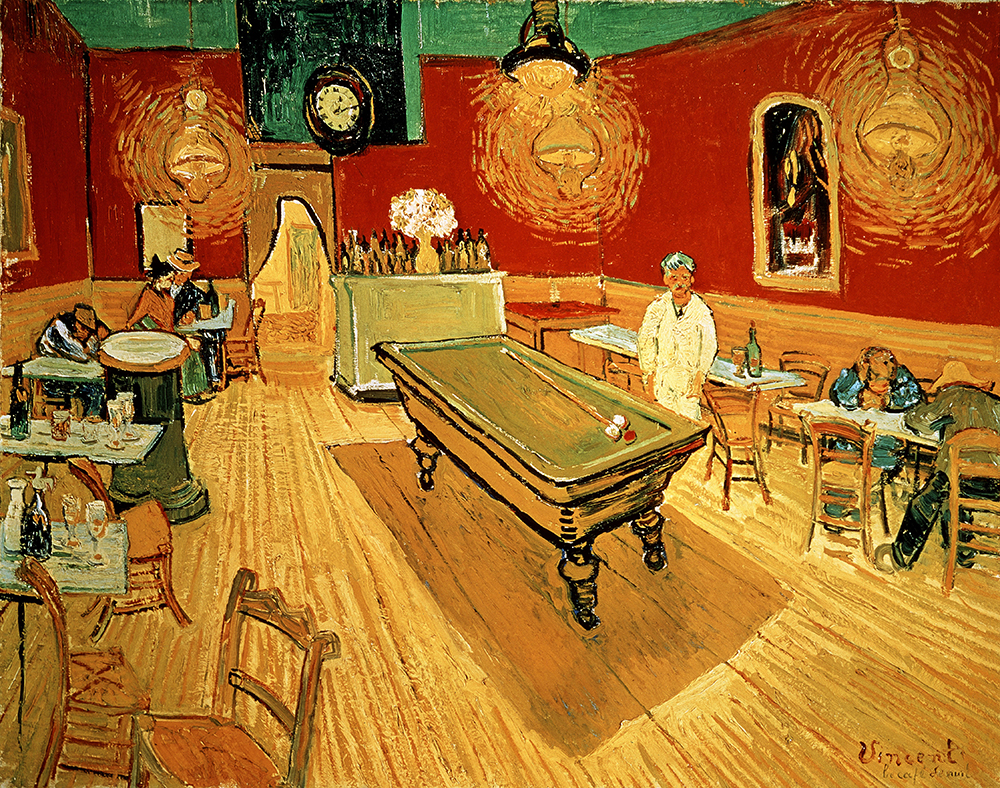I curse the night, yet doth from day me hide.
—William Drummond, 1616
Blue Night, London (detail), by Joseph Pennell, c. 1900. The Los Angeles County Museum of Art, Mr. and Mrs. William Preston Harrison Collection.
Perhaps day becomes night when the signs of the city light up. What were in the daytime complete words, like linwood super foods, become, upon illumination, the mere and bereft od fo. Over the pickup window of the algreens, it is dr e t ru, china market abbreviates to china, flacos auto to flac to. Nightfall in this city—the kind of city where businesses either can’t afford to fix their signs or don’t care to, or just haven’t yet—could be defined as “the moment in which some of the letters of our words disappear.” A few words, however, remain clear and fully spelled in the fresh semidarkness. tension envelopes, for example, never burns out.
Perhaps night begins when the gray-green of dusk meets the sensors built into the dashes of cars. Light sensors lack subtlety. All absence of brightness is to them, as Mary Shelley once described an eclipse, “night, sudden, rayless, entire.” The headlights click on without notice, meet each other on the streets, not quite needed yet except to announce night’s probable approach. Handfuls of cars line up at the now-illuminated signs of drive-throughs. Fast-food workers—elderly women, teenagers, mothers of small children, and people just out of prison—are at the end of their evening shifts or the beginning of their night ones. The workers stand against the aggressively lit backdrop of the drive-through window and lean into dusk to hand out taco supremes or medium fries.
The voices of the drive-through workers almost carry to the sidewalks as dark falls. The air cools, and drivers roll down their windows so that whatever song plays can drift behind them like whiffs of a rich person’s perfume. At the intersections, there is competing spill off, music against music, or sometimes, if everyone is listening to the same station, music in stereo with satisfied sideways looks from car to car. Motorcycle engines rev with greater pride at night. Perhaps night begins when sound becomes more vivid than sight.

Twilight, by Carl Moll, c. 1899. © Erich Lessing / Art Resource, NY.
Helicopters—police, ambulance, local news—circle overhead more, make more clatter, become more arrogant, ominous, and loud. They, along with all sirens, warn the rest of the city that despite the apparent permissions of the coming night, the social apparatus remains intact and vigilant. Helicopters are to night as lawn mowers and leaf blowers are to Saturday mornings. They exist to ruin everything wild.
“Doctor,” says Nora Flood, the protagonist of Djuna Barnes’ Nightwood, “I have come to ask you to tell me everything you know about the night.” In that novel night has reached its irrefutable peak. There is no question that night is night when it is three am in 1920s Paris: “French nights are those which all nations seek the world over.” Paris at the witching hour is night’s apogee, not like dusk in a roughshod midwestern American city. America is a place where, says the doctor, “the night is a skin pulled over the head of day.” Nora is fraught, betrayed by the woman she loves. The doctor, Matthew O’Connor, had been sleeping in full makeup and a long nightgown, an appropriate expression, Nora thinks, of both his priest-like nature and the “grave dilemma of his alchemy.” The doctor then asks Nora, not without irony, if she has ever thought about the night. “Thinking about something you know nothing about,” Nora says, “does not help.”
That Nora claims to know nothing about the night is appropriate to the night. Night’s mysteries are definitive. Certainties are what happens when the sun comes out. To know what the night means is to know what shrugs off being known in preference for what can be hazily remembered. The prolific Italian notebook keeper Giacomo Leopardi, in his Zibaldone, asserts that mystery lends night its poetic nature. “Notte,” he writes of the word night, “confounds objects so that the mind is only able to conceive a vague, indistinct, incomplete image, both of the night and whatever it contains.” To know the night is a lot like knowing poetry, and knowing poetry requires what Keats called “negative capability,” the capacity for “being in uncertainties, mysteries, doubts, without any irritable reaching after fact and reason.” To know the night means having the clarity that some things are and should be and always will be hidden, for the night has been, or is, or should always be, the time of lovers, revolutionaries, and other conspirators. The night world is that which should be, or once always was, veiled.
It makes sense, then, that night is the precondition for witches. The first accusation against any suspected witch is almost always that she goes out into it. In sixteenth-century Italy, good witches—the benandanti—gathered each Thursday for midnight battles with the wicked ones, armed, according to historian Carlo Ginzburg, only with stalks of fennel. Other witches merely toured, searching the phantasmagoria of the darkness for gossip and mild trouble. Witches were the flaneurs of the night sky. As Silvia Federici illustrates in Caliban and the Witch, the regulation of the night and the persecution of witches and sex workers—the other women considered guilty for roaming at night—were all part of the same operation of history that attempted to tame the bodies of the proletariat by extending their day into night. “Magic,” Federici writes, “seemed a form of refusal of work.” In order for industrial capitalism to take hold, night—and the freedoms the poor and oppressed once found in it—had to be conquered first.
Night was once an obvious and self-contained entity, but the border skirmishes between day and night have been going on now for centuries due to these incursions. Shift work was an attempt to usurp the rule of the sun. One of the things that Nightwood’s Dr. O’Connor knows about the night is that “the nights of one period are not the nights of another. Neither are the nights of one city the nights of another.” Night is never a general and universal experience. The nights of my city and my time are not always like the nights of yours.
Karl Marx, who wrote a book obsessed with night (Capital, volume one), or at least partly so, briefly mentions an English judge who must adjudicate a definition of night with “Talmudic sagacity.” Trying to enforce a labor act that nominally prohibits night work for children, the judge faced the problem that the legislative definition of night differs from what anyone would think of as the actual night. In Judgment of Mr. J.H. Otway, Belfast. Hilary Sessions, County Antrim, 1860, the judge’s decision is contortionist. It’s not difficult to see why Marx was amused. Judge John Hastings Otway starts by asserting that night could be defined in its etymological sense as a word with “proximately a German derivation and [that] means the period which is marked by the sun’s declension below the horizon as distinguished from day and, as the opposite of it, it is the time of darkness, or it may be for some purposes of twilight.” Otway goes on to quote John Milton purportedly quoting God: “Light the day, and darkness night.”
The tone of Otway’s decision is almost coy, but the meaning comes through. The same legislation that claimed to protect the night was a statutory contributor to its ruin. Industrial capitalism and its new laws extended daytime—via the grafted-on version of it called “the working day”—past darkness and then well into it, from five thirty am to nine thirty pm, a stretch that previously constituted day (if day is “light”) only at midsummer. Common law, which Otway turned to next, did not veer from the laws of nature or poetry in matter of the night. The common-law understanding of night, as it relates to crimes like burglary, also refers to a condition of light, not to the position of a clock’s hands.

She Never Told Her Love (detail), by Henry Peach Robinson, 1857. The Metropolitan Museum of Art, Gilman Collection, Purchase, Jennifer and Joseph Duke Gift, 2005 (CC0).
Marx despised the infringement of the working day on what once was night. He wrote that the capitalists would do anything to keep labor working every available hour, that even “the prolongation of the working day beyond the limits of the natural day, into the night, only acts as a palliative. It quenches only in a slight degree the vampire thirst for the living blood of labor.”
If these particular vampires could invent extra hours in the day, they would try to, always seeking condensations of productivity and amplifying nocturnal intrusions, like how people now sometimes get tricked into answering their work emails at one in the morning. When they try to tell us that night is day, writes Marx, that is when “capital celebrates its orgies.”
Night and day were once a near-universal source of contrast. It’s as plain as night and day. Night, too, is our primal half source of all analogy, so foundational to how we compare and organize our perceptions of the world that night is to day like day and night are to each other. The rotation of the earth itself gives us a first and incontestable example of how to distinguish one thing from another. And so the affront of the working day upon the night was egregious not only against “nature,” God, Milton, and workers: it was also an affront to common sense. Because these are the two most distinct things on earth, no one can tell us that night is day, and yet they do.
It is not just the clock or capital that tries to fool us into believing the world has gone topsy-turvy. Electric light does, too, but it never creates a convincing form of daylight: pineal glands are the body’s lie detectors, refusing to believe that the overhead fluorescent of a predawn Walmart is the sun. Night workers are sicker, more depressed, and die earlier and with more stress. The industrial revolution, however, was not the beginning of night work. Servants, mothers, those who care for the sick and infirm have always had their sleep disrupted at the call of someone else. Some trades, like bread baking and waste collecting, have mostly been performed if not at night proper then during the hours at the tail end of it. Capitalism could not invent night work, but it did invent the insult of trying to tell us that night isn’t night.
Day doesn’t fall: night does. Light is slick and fluid, darkness is heavy and can grow heavier. Everything we know about the night inspires catalogues but defies dissection, for the night, despite how it gets thick, brings no body. Night has no anatomy, just inventory. Night contains. Perhaps the greatest of all list makers, Walt Whitman, wrote a poem, “The Sleepers,” about the contents of the night. In 1856 he called it “Night Poem,” then called it “Sleep-Chasings,” and did not resolve its final title until 1871. In this poem sleep is a democracy shared across social category, its particulars accrued by the poet-wanderer who creeps through it, watching people asleep in their beds:
The consumptive, the erysipalite, the idiot,
he that is wrong’d,The antipodes, and every one between
this and them in the dark,I swear they are averaged now—one is no
better than the other.
Sleep redeems the species—all, he says, are now “beautiful.” In sleep, the felon is freed from prison, the slave is free, the sick are relieved. The whole world holds hands. Sleep is night’s utopia, but the poem has no comment about what happens when there is a lack of it.
By night an atheist half believes a God.
—Edward Young, 1745“Sleep,” as Dr. O’Connor says in Nightwood, “demands of us a guilty immunity.” Dream crimes can’t be criminal, and what we don’t see as we sleep is that for which we can never be held accountable. The night of the sleepless happens in the hidden-away places, the grossly lit prisons, the hulls of airplanes filled with strangers who toss and turn in restless and intimate proximity, nursing homes. Night lasts longer for the institutionalized. Hospitals are hostile to sleep: cold air infused with beeps, bright hallways, glowing screens, a would-be emergency hovering over any would-be sleeper, births and deaths and the suffering that is endured between. Nurses and paraprofessionals circulate in the false noon of hospital passages at midnight, speak softly when they enter rooms, and rouse sick sleepers despite this. The night of the city enters the night of the hospital through the portal of emergency rooms where parents hold their children, and other people hold their injured limbs and hold up their heavy heads, too, waiting for their turn.
Back in the streets, night keeps falling. In houses and apartments, curtains are drawn, and plastic horizontal blinds are let down by white strings. Children, having been fed dinner, are put to bed or set in front of screens by exhausted mothers who go to bed or sit in front of screens. Dogs stop barking. Workers lock up shops or change out cash drawers. Revelers make their first timid steps into reveling.

The Night Café, by Vincent van Gogh, 1888. © Album / Art Resource, NY.
People stand on corners waiting for the buses that have grown infrequent. The waiting fidget or slump, tired or impatient or both, wanting to go their way. Once, at a busy bus stop, someone brought a rocking chair. It stayed there for a week: feral art. In this city so far this year, 155 people have been murdered, some shot on the street, at least one at a bus stop where he was waiting in the dark, the shooters leaning out of a passing car into the night. Fourteen of the murdered were killed by the police. The plexiglass holders of bus-route maps have been pierced by bullets, too. Things get fixed in slow motion here, so the people who must wait for the buses wait near the bullet holes, stuck in the slivers of vacant time reserved for the poor. For the carless in a spread-out city, night begins when it gets harder to get around. Inside the buses itinerant drinkers have already started their parties, semibelligerent and huddled in the back. In the front a tired-eyed mother holds her tired-eyed toddler, one resisting sleep, the other resisting wakefulness. “The very constitution of twilight,” says Dr. O’Connor, “is a fabulous reconstruction of fear.”
The crickets in the parking lots sing as though they have never heard of any of this. This city at dark is always the backdrop of a noir that no one ever thinks to film. Then a pale old man in slippers and a robe pedals a bike slowly down the sidewalk from the liquor store, white plastic bag with a happy face on it in hand. have, the bag read when there was light enough to read it, a nice day. The first gunshot of night echoes, too, far away and negligible. A man in a reflective vest dances around in the median waving a cardboard will work 4 food. It’s the new moon, so the earth is at its darkest. Only two or three stars can be found in the sky.
